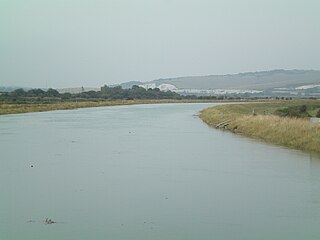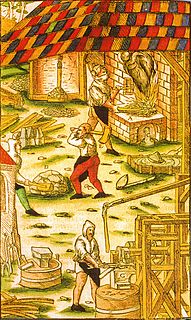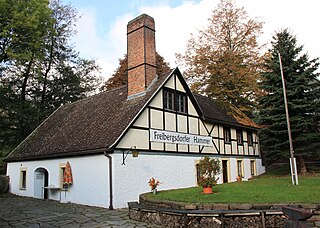

The Eisenhammer Weida ("Weida Iron Hammer Mill") is the oldest, working hammer mill in the German state of Thuringia. The iron hammer works lies on the River Auma in the village of Liebsdorf in the borough of Weida, just below the Auma Dam.


The Eisenhammer Weida ("Weida Iron Hammer Mill") is the oldest, working hammer mill in the German state of Thuringia. The iron hammer works lies on the River Auma in the village of Liebsdorf in the borough of Weida, just below the Auma Dam.
In 1770 the first attempts took place to erect a hammer works on this site. The iron hammer forge was built using an available weir which was being used to irrigate the sheep pastures of Liebsdorf. In order to make better use of the water power, the building was dug into the earth, rather like a cellar. This enabled a drop of 2.70 metres for the two overshot wheels.
In earlier times, the mill made tools and components for other mills, as well as hammers, wagon parts, metal tyres, fittings, anvils, surface plates, wagon axles and – usually in summer when the water level was low – horseshoe nails.
The bell clappers made here were well known far beyond Weida; several are supposed to have weighed four hundredweight. These clappers may be found today in Naumburg Cathedral, Erfurt Cathedral, in Magdeburg, in Cologne and even in the Church of the Redeemer in Jerusalem.
The operation was closed in 1921.
In 1990 work began on renovating the technical monument. With the aid of monument conservation the following work was carried out: renewal of the roofing and roof truss, restoration of the mill ditch and rebuilding of two weirs as well as the restoration of the east wall.
These renovation measures were carried out under the supervision of an architect, an statistician and a geologist. In 1990 the hammer mill was sold to a private buyer.
Coordinates: 50°45′53″N12°01′49″E / 50.764738°N 12.030334°E

The Ouse is a river in the English counties of West and East Sussex. It rises near Lower Beeding in West Sussex, and flows eastwards and then southwards to reach the sea at Newhaven. It skirts Haywards Heath and passes through Lewes. It forms the main spine of an extensive network of smaller streams, of which the River Uck is the main tributary. As it nears the coast it passes through the Lewes and Laughton Levels, an area of flat, low-lying land that borders the river and another tributary, the Glynde Reach. It was a large tidal inlet at the time of the Domesday book in 1086, but over the following centuries, some attempts were made to reclaim some of the valley floor for agriculture, by building embankments, but the drainage was hampered by the buildup of a large shingle bar which formed across the mouth of the river by longshore drift.

The River Don is a river in South Yorkshire and the East Riding of Yorkshire, England. It rises in the Pennines, west of Dunford Bridge, and flows for 70 miles (110 km) eastwards, through the Don Valley, via Penistone, Sheffield, Rotherham, Mexborough, Conisbrough, Doncaster and Stainforth. It originally joined the Trent, but was re-engineered by Cornelius Vermuyden as the Dutch River in the 1620s, and now joins the River Ouse at Goole. Don Valley is the local UK parliamentary constituency near the Doncaster stretch of the river.

The River Eden in West Kent is a tributary of the River Medway. It travels through the Weald of Kent from the border with Surrey, rising from the source in Titsey parish, Surrey, grid reference TQ 420 551, about 350 metres north of Clacket Lane motorway services, and flowing eastward through the Wealden clay to join the River Medway near Penshurst, Kent, grid reference TQ 537 434. The section from its source to where the Gibbs Brook joins it is also known as the Broadmead Water. Its name is a back formation deriving from Edenbridge, the main town through which it flows, and which was originally called in the Old English language "Eadhelmsbrigge".

Durrington or High Salvington Windmill is a Grade II listed post mill in High Salvington, Sussex that has been restored and is in full working order. The mill stands 320 feet (98 m) above sea level and is able to take advantage of incoming sea winds.

The River Kent is a short river in the county of Cumbria in England. It originates in hills surrounding Kentmere, and flows for around 20 miles (32 km) into the north of Morecambe Bay. The upper reaches and the western bank of the estuary are located within the boundaries of the Lake District National Park. The river flows in a generally north to south direction, passing through Kentmere, Staveley, Burneside, Kendal and Sedgwick. Near Sedgwick, the river passes through a rock gorge which produces a number of low waterfalls. This section is popular with kayakers as it offers high quality whitewater for several days after rain. The village of Arnside is situated on the east bank of the Kent estuary, just above Morecambe Bay, and a tidal bore known as the Arnside Bore forms in the estuary at this point on high spring tides.

Saugus Iron Works National Historic Site is a National Historic Site about 10 miles northeast of Downtown Boston in Saugus, Massachusetts. It is the site of the first integrated ironworks in North America, founded by John Winthrop the Younger and in operation between 1646 and approximately 1670. It includes the reconstructed blast furnace, forge, rolling mill, shear, slitter and a quarter-ton drop hammer.

Catrine is a village in East Ayrshire, Scotland which was formerly a centre of cotton manufacture.

A hammer mill, hammer forge or hammer works was a workshop in the pre-industrial era that was typically used to manufacture semi-finished, wrought iron products or, sometimes, finished agricultural or mining tools, or military weapons. The feature that gave its name to these workshops was the water-driven trip hammer, or set of hammers, used in the process. The shaft, or 'helve', of the hammer was pivoted in the middle and the hammer head was lifted by the action of cams set on a rotating camshaft that periodically depressed the end of the shaft. As it rose and fell, the head of the hammer described an arc. The face of the hammer was made of iron for durability.

Smíchov is a district of Prague, the capital of the Czech Republic, and is part of Prague 5. It is on the west bank of the Vltava river.

The River Tillingbourne runs along the south side of the North Downs and joins the River Wey at Guildford. Its source is near Tilling Springs to the north of Leith Hill at grid reference TQ143437 and it runs through Friday Street, Abinger Hammer, Gomshall, Shere, Albury, Chilworth and Shalford. The source is a semi-natural uninhabited area. The catchment is situated on sandstone which has a low rate of weathering. The Tillingbourne is 24 km (15 mi) in length.

The River Whitewater rises at springs near Bidden Grange Farm between Upton Grey and Greywell in Hampshire, England. It flows northeast and is a tributary of the River Blackwater near Swallowfield. Its headwaters flow over chalk and there is little pollution making the River Whitewater rich in wildlife. It was noted on Jansson's map of Hampshire of 1646.

The River Teise is a tributary of the River Medway in Kent, England. It begins in Dunorlan Park in Tunbridge Wells. and flows eastwards past Bayham Abbey and then through Lamberhurst. 2 miles downstream of Lamberhurst the small River Bewl, on which is the reservoir Bewl Water, joins the Teise.

Upthorpe Mill is a Grade II* listed post mill and Scheduled Ancient Monument at Stanton, Suffolk, England, which has been restored to working order.

Little Matlock Rolling Mill also known as Low Matlock Rolling Mill is a Grade II* Listed building situated on the River Loxley in the village of Loxley on the outskirts of the City of Sheffield, South Yorkshire, England. The building continues to operate as a rolling mill, owned and operated by Pro-Roll Ltd, a specialist hand rolling company. A brick building extension was added to the original 1882 structure in 1939.

The Pont-y-Cafnau is a 14.2-metre (47 ft) long iron truss bridge over the River Taff in Merthyr Tydfil, Wales. The bridge was designed by Watkin George and built in 1793 for his employer, the Cyfarthfa Ironworks, to support both a tramway and an aqueduct to carry limestone and water into the works. A Grade II* listed building and Scheduled Ancient Monument, the Pont-y-Cafnau is the world's earliest surviving iron railway bridge.

The Frohnauer Hammer is an historic hammer mill in Frohnau, a village in the municipality of Annaberg-Buchholz in the Ore Mountains of southeast Germany. The mill is an important witness to proto-industrial development in the Ore Mountains. Of the once-numerous hammer mills only three others remain working in Saxony: the Dorfchemnitz Iron Hammer Mill, the Grünthal Copper Hammer Mill and the Freibergsdorf Hammer Mill.

The Freibergsdorf Hammer Mill is an old hammer works that was used for metalworking in the village of Freibergsdorf in the German Ore Mountains. The site represents an important witness to proto-industrial development in the Ore Mountains. Of the once-numerous hammer mills, only three others remain working in Saxony: the Frohnauer Hammer, the Dorfchemnitz Iron Hammer Mill, and the Grünthal Copper Hammer Mill.

Mill Island is a historic area located in the Old Town of Bydgoszcz, covering approximately 6.5 ha: today it is a place with cultural and recreational facilities, surrounded by the Brda river and its branch. The island received the 2012 Certificate for Best Tourist Attraction from the Polish Tourist Organisation.

Green's Bridge, or Greensbridge, is an elegant, Palladian-style, limestone arch bridge that crosses the river Nore in Kilkenny, Ireland. The bridge is a series of five elliptical arches of high-quality carved limestone masonry with a two-arch culvert to the east. Its graceful profile, architectural design value, and civil engineering heritage endow it with national significance. Historian Maurice Craig described it as one of the five-finest bridges in Ireland. It was built by William Colles and designed by George Smith, and was completed in 1766. The bridge was 250 years old in 2016.

The Tobiashammer is a large, water-driven hammer mill in Ohrdruf in the German state of Thuringia. The mill, which dates to 1482, has been an industrial monument and museum since 1983.